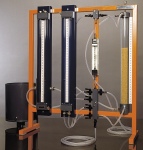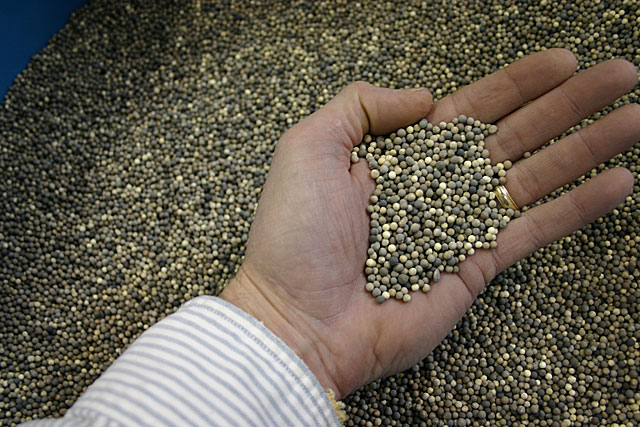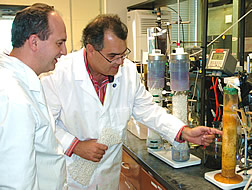Packed bed reactors, also known as fixed bed reactors, are often used for catalytic processes. Pictured below is a fixed bed reactor used in a synthetic process. Pictured below is a packed bed reactor used in the NASA Glenn Research Center. The experiment is designed to develop packed bed reactors for microgravity environments by studying fluid flow through porous media in microgravity.
(Copyright NASA/Glenn Research Center)
General Information
Packed bed reactors consist of a cylindrical shell with convex heads. Most are vertical and allow reactants to flow by gravity. Inside the reactor is an immobilized, or fixed, bed of catalyst. Packed bed reactors are heterogeneous reaction systems. The picture below shows an apparatus used to study flow through a packed column.
(Copyright Armfield Limited, Ringwood,UK)
Equipment Design
The animation below shows the basic operation of a packed bed reactor. The reactants (green) enter the reactor on the top, then flow through. Upon entering the reactor the reactants flow through the packed bed of catalyst. By contacting with the catalyst pellets, the reactants react to form products (blue), which then exit the reactor on the bottom. Note the concentration gradient within the reactor.
When designing a packed bed reactor one must take into account the active life of the catalyst. This will affect the length of time a bed of catalyst may be used and thus how long the reactor may be run before the catalyst needs to be regenerated.
Catalyst pellets are usually granular, with diameters from 1 – 5 mm. They can be loaded into the reactor in several ways: as a single bed, separate shells, or in tubes. Catalysts are typically made from nickel, copper, osmium, platinum, and rhodium. The catalysts shown below are made of precious metal on 3.175 mm ceramic beads and are used in an electric catalytic oxidizer that treats air streams contaminated with volatile organic compounds (VOCs).
(Copyright Falmouth Products Inc., Falmouth, MA)
Usage Examples
Packed bed reactors have a wide range of uses for catalytic reactions. They are also widely used in small-scale commercial reactions. The picture below shows soil scientists using a small-scale packed-bed reactor to test cost-effective methods of removing ammonia from livestock wastewater.
(Copyright U.S. Department of Agriculture)
Advantages
- High conversion rate per weight of catalyst.
- Easy to build.
- More contact between reactant and catalyst than in other types of reactors.
- More product is formed due to increased reactant/catalyst contact.
- Low cost of construction, operation, and maintenance.
- Effective at high temperatures and pressures.
Disadvantages
- Difficult temperature control.
- Temperature gradients may occur.
- Catalyst difficult to replace.
- Channeling of gas stream can occur, leading to ineffective regions in the reactor.
- Side reactions possible.
- Heat transfer to or from reactor can be difficult.
Acknowledgements
- Armfield Limited, Ringwood, UK
- Falmouth Products Inc., Falmouth, MA
- NASA/Glenn Research Center
- U.S. Department of Agriculture
References
- Fogler, H. Scott. Essentials of Chemical Reaction Engineering. Upper Saddle River, NJ: Prentice Hall, 2011. Print.
- Hill, Charles G., Jr. An Introduction to Chemical Engineering Kinetics and Reactor Design. New York: John Wiley & Sons, Inc. 1977. Print.
- Perry, Robert H., and Don W. Green. Perry’s Chemical Engineers’ Handbook. 7th ed. New York: McGraw-Hill Inc., 1997: 7-19 – 7-22. Print.
- Trambouze, Pierre, Van Landeghem, Hugo, and Wauquier, Jean-Pierre. Chemical Reactors. Houston: Gulf Publishing Company, 1988. Print.
- Walas, Stanley M. Chemical Process Equipment: Selection and Design. Boston: Butterworth-Heinemann, 1990. Print.
- Walas, Stanley M. Reaction Kinetics for Chemical Engineers. New York: McGraw-Hill Inc., 1959. Print.
Developers
- Sam Catalano
- Alex Wozniak
- Kelsey Kaplan




